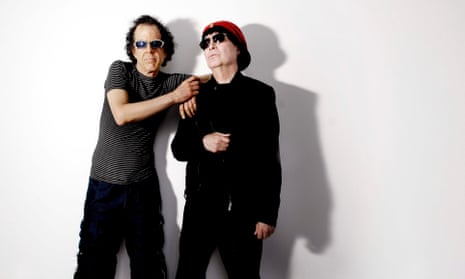About 100 minutes into Adam Curtis’s latest documentary, HyperNormalisation, there’s a montage of movie scenes in which skyscrapers are blown up by bad guys, crumbling into themselves as people leap from flaming top-storey windows. All of these films, Curtis tells us, were made before 9/11. As the strangely prophetic scenes keep coming, Suicide’s Dream Baby Dream drones in the background.
In the context of a film convinced that we have “retreated into a dream world that allows dark and destructive forces to fester and grow outside”, Martin Rev and Alan Vega’s track seems to mock the state of blissful ignorance Curtis believes society has wrapped itself in. Dream Baby Dream is a song that hangs between hope and nihilism, and Curtis’ disaster reel embraces the latter.
Released in 1979, two years after an earlier incarnation, Keep Your Dreams, had been recorded, Dream Baby Dream is unquantifiable. There’s a weightlessness to it, a timelessness too, which perhaps explains why it’s circled back around. Anchored by an urgent electric drum beat that lurks like a ticking bomb beneath Vega’s murky vocals, its lyrics are stark, yet impenetrable. “Dream baby dream, forever and ever,” sings Vega in a voice that has been likened to Elvis – though it’s more of a hazy drawl, with Vega swallowing his consonants as if he lacks the enthusiasm to let his lips touch. “Yeah those dreams keep you free.”
Where Curtis drew on the song’s darkness, Bruce Springsteen found hope. His cover version, which he recorded in 2014 after performing it live for nearly a decade, shaves off some of the original’s eeriness – with its purposely flat, unresolved melodies – and sneaks in a little more sentimentality. Where Vega mumbles the line, “I see that smile on your face now baby, yeah you got the idea now”, Springsteen sings, “I just wanna see you smile / Now I just wanna see you smile”. He adds new lyrics too: “Come on and open up your hearts … come on darling and dry your eyes.” Suicide’s refrain is a vague suggestion, of which even they don’t seem entirely convinced. Springsteen’s is a command: “Dream, baby, dream.”
“A lot of bands have done my stuff, Suicide stuff, and they basically try and copy and do it the way that you do it,” Vega said of Springsteen’s cover back in 2005. “Thank God – finally somebody did their version of it. He did it his way, and such a great way, that I’m going to have to sing it that way, or not sing it at all any more.”
It’s this version that crops up in another film released this year, Andrea Arnold’s American Honey. In one of the road movie’s best scenes, Sasha Lane’s Star clambers into the passenger seat of a lorry to try to sell a magazine subscription to its middle-aged driver. He’s in a rush, he says, so she decides to travel with him to his next pit stop. Something bad is going to happen. You can feel it in the dank, dusty highway air. Besides, the rules of cinema dictate that vulnerable young women don’t get into cars with strange men without something very bad happening. But it doesn’t. Instead, the driver puts on a tape of Dream Baby Dream, Star announces, delighted, “I know this one!” and for a blissful couple of minutes the two of them sing along tunelessly as he drives. It’s a moment of pure optimism.

The song’s ambiguity lends itself well to other artists’ interpretations; they find just enough space to pour themselves into it. Savages started playing it live, then released their live version as a B-side in 2014. When Vega died earlier this year, Arcade Fire’s Win Butler recorded a version under his DJ Windows 98 moniker - (Arcade Fire have performed it live though it seems to have since disappeared from the internet). Neneh Cherry and the Thing contorted it into a scattered jazz number in 2012.
It would be tempting to try and find a reason that the song has been reimagined so often in recent years. To suggest, maybe, that its enigmatic and contradictory tone are fitting in today’s unsettled climate. But, in truth, the song’s appeal is no more tangible now than it was almost 40 years ago. “Some folks find it sad,” says Cherry, “others endlessly happy and blessed. I think it’s one of those songs that will never go away.”

Comments (…)
Sign in or create your Guardian account to join the discussion